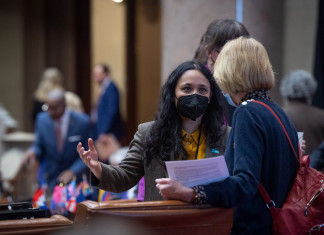At an open hearing last week, Milan residents spoke up in clear opposition to Verizon Wireless’ proposal to put up a cell tower in the town to fill coverage gaps along the Taconic Parkway.
Several town residents who own property surrounding the proposed site off Academy Hill Road told town planners at their Aug. 8 meeting that Verizon’s application should remain open and that it would have a much more significant visual impact on the landscape than proponents were stating.
There were also concerns voiced about the tower’s effect on property value in the area and that the board did not give enough notice about the planned tower to gauge the full sentiment of town residents.
Verizon’s lawyer, Scott Olson, who presented the initial proposal to town planners in March, told them this time that the new tower was needed because existing towers would not close coverage gaps, which at half a mile each are deemed “significant” and enough time to lose a cell phone call while driving 55 mph in a car.
“There are huge gaps in coverage even under the best scenario using existing cell tower infrastructure. The existing towers are simply too far apart,” Olson said.
The proposed three-legged lattice tower would be built west of the Taconic State just off Academy Hill Road between North Road and Ferris Lane. Olson said that the cell tower would have negligible visual impact, noting “The site is well-sited in that it covers the service areas and will not be seen from any significant scenic areas.”
He also told the town planners that the special use terms of the application were in accordance with local law and they should close the application.
The engineer hired by the town of Milan, Ronald Graiff, provided the planners with technical details, such as the standard of signal strength, relative coverage to the height of the structure, and what designs the town might employ. His conclusions indicated that the tower needed to be a minimum of 150 feet in order to meet a signal strength of -85 db in the coverage areas because of the terrain of the surrounding area.
Graiff also said that, while the tower location was well-sited to meet the criteria posed by Verizon, the location may not be the only suitable one in the area.
Joseph Grotto, a resident of Milan for 39 years, wrote a strongly worded letter saying that the proposed tower height of 150 to 160 feet is “excessive” and “… would certainly diminish the value of surrounding properties.” Grotto also noted, “A quick canvas of local residents showed that they all had ample cell service and that this tower would only benefit passers-by on the Taconic Parkway.”
At the meeting, Grotto added that “the lattice-type towers are very large and very, very ugly.”
Grotto and other residents intend to seek legal representation to oppose Verizon’s application or, at the very least, force a design change from the lattice structure to a monopole structure, which is thinner, can be painted and made to blend in with the surroundings.
The application was left open until the next planning board meeting on Sept. 4 at 7pm at Town Hall.
Correction: In the Aug. 14 story on the proposed cell tower in Milan, we incorrectly reported that independent engineer Ronald Graiff said the minimum required signal strength was -65 dBm. In fact, Graiff said the minimum was -85 dBm. Graiff’s last name was also misspelled in the article.







Facebook Comments